Nonsan Gwanchoksa Temple (관촉사(논산))
9.9 Km 19415 2021-12-03
25, Gwanchok-ro 1beon-gil, Nonsan-si, Chungcheongnam-do
+82-41-736-5700
Gwanchoksa Temple in Nonsan, Chungcheongnam-do is located at the foot of Banyasan Mountain (100 meters in elevation). This temple enshrines a Seokjomireukbosalipsang Buddha (Treasure), which was built over the course of 38 years, beginning in 967 during the Goryeo period. According to legend, while a lady was picking fernbrake on Banyasan Mountain, she heard a baby crying. When she went over, there was no baby but instead was a large rock sticking out from the ground. Upon hearing this story, the government ordered a Buddha statue to be made from the rock. This Buddha statue, widely known as ‘Eunjimireuk Buddha,’ is the largest stone Buddha in Korea (18.12 meters in x_height, 9.9 meters in girth, 1.8 meters in the length of ears, 2.43 meters at the x_height of crown). There are many other cultural heritages in this temple and every April, a splendid cherry blossom tunnel stretching from Nonsan to Gwanchoksa Temple is at its peak.
Daejosa Temple (Buyeo) (대조사 (부여))
10.4 Km 20717 2020-01-08
112, Seongheung-ro 197beon-gil, Imcheon-myeon, Buyeo-gun, Chungcheongnam-do
+82-41-833-2510
Below Seongheungsanseong Fortress (built in 501 during the Baekje Kingdom) in Buyeo is an ancient temple called Daejosa (great bird temple). Inside the temple grounds stands a giant standing stone Buddha statue looking toward the east. The temple, which was founded during the 5th year of the Baekje Kingdom, has an interesting legend behind its origin.
According to the legend, an old monk fell asleep after praying under a large rock on the slopes of Seongheungsan Mountain. In his dream, a large bird glowing in gold flew in from the west and sat on the rock where Daejosa currently stands. While the bird continuoulsy flapped its wings, a ray of light shone on the rock and it was there that the statue of Avalokitasvara Bodhisattva appeared.
The old monk had the same dream at the same time for many days. He recounted his dream to the seongju (castle lord), who then reported it to King Seong of Baekje. The king interpreted the dream as a sign that it was the right time to move the capital of Baekje to Sabi (now Buyeo) and ordered the construction of a large temple at the location that appeared in the dream. The temple was so big that even at a hurried pace, it would still take 10 years to build. Workers had to work day and night, and every time the workers felt tired, birds would come singing to brighten up the atmosphere so that the workers can forget the fatigue and continue working. Hence, the temple was completed after only five years. Because of the golden bird, the temple was named Daejosa, literally meaning "temple of a great bird."
The rock on which Avalokitasvara Bodhisattva appeared in the dream was recreated as a stone statue of a Buddha. This standing stone Maitreya Bodhisattva statue is a fine work of sculpture which, along with the stone Bodhisattva of Gwanchoksa Temple (Treasure No. 218), is a representative heritage of the early Gorye period.
In front of Wontongbojeon Hall (a hall enshrining Avalokitasvara Bodhisattva) stands a pagoda. In the old days, the stone pagoda used to have only the cover stones but as the pagoda body stones were found, the structure was completely restored in 1975. This pagoda is assumed to have been built in the early days of the Goryeo Kingdom.
Buyeo Garimseong Fortress (부여 가림성)
10.7 Km 7147 2020-08-11
167, Seongheung-ro 97beon-gil, Buyeo-gun, Chungcheongnam-do
+82-41-830-2880
Garimseong Fortress is a stone fortress built on the lower reaches of the Geumgang River to protect Sabiseong Fortress, the capital of the Baekje dynasty. The fortress' parking lot is only 200 meters away from the southern entrance, allowing visitors to easily access and enjoy the view from this historical fortress. By ascending the stairway by the rocky cliff, a large tree comes into view. Known to be over 400 years old, this tree is called the "Love tree of Seongheungsan Mountain" and has even made an appearance in the drama "Seodongyo (200)." The fortress is also popular as a sunrise spot, serving as Buyeo-gun’s New Year's Eve festival venue.
Iksan Sungnimsa Temple (숭림사(익산))
11.9 Km 7496 2024-04-07
495-57, Baekje-ro, Iksan-si, Jeonbuk-do
+82-53-862-6394
Sungnimsa Temple is one of the major temples in Iksan under Geumsansa Temple and was believed by some to have been built by monk Jinpyo Yulsa during the reign of King Gyeongdeok (742-764) during the Silla period. Others believe that the temple was established during the first year of King Chungmok of the Goryeo dynasty in 1345. Sungnimsa Temple was named in honor of great monk Bodhi-Dharma, who practiced seated Zen meditation for nine years at Sorimsa Temple located deep inside Sungsan Mountain in China. The temple was burnt down during the Imjin War (1592-1598), leaving only Bogwangjeon Hall. Bits and pieces of the temple were later restored in 1697, 1819, and 1892.
Buyeo Naseong Fortress [UNESCO World Heritage] (부여 나성 [유네스코 세계문화유산])
12.7 Km 27294 2021-07-22
100-11, Dongmun-ro142beon-gil, Buyeo-gun, Chungcheongnam-do
+82-41-830-2623
Buyeo Naseong, also known as the Outer City Wall, was built to protect the capital of Baekje, Sabi. It has a x_height of about 8.4 kilometers. The wall surrouned Busosanseong Fortress and extended to the city of Buyeo.
The wall is one of the oldest walls along with Naseong in Pyeongyang and it is estimated to have been built around 538, when the Baekje capital was changed from Woonjin (current Gongju) to Sabi (current Buyeo). The wall of the fortress starts from the site where Dongmun (East gate) was located to the area of Geumgang River, made by piling soil up. However, only a few traces remain of its former glory.
For now, it leaves a blurry trail including a 20 meter area to the east of Cheongsanseong Fortress, Dongmun Bridge from Seokmok-ri, and an area from Pilseobong Peak to Yeomchang-ri. While the outer wall is sharply sloped, the inner wall was built with a gentle slope to make it easier for horses to reach the guard posts on the top of the wall. Inside the fortress, the palace of Baekje, government offices, houses, temples, stores and protected facilities can be seen. The entire structure of Naseong Fortress features Geumgang River in the south and west sides, providing a natural double-defense system. The wall was one of the important outer defense facilities along with Cheongsanseong and Cheongmasanseong Fortresses.
* Area: 554,591 ㎡
Nonsan Tapjeongho Suspension Bridge (논산 탑정호 출렁다리)
13.7 Km 0 2022-12-29
Jongyeon-ri, Nonsan-si, Chungcheongnam-do
+82-41-746-6645
Tapjeongho Suspension Bridge is located in the second biggest lake in Chungcheongnam-do. With clear waters from Daedunsan Mountain filling the lake, visitors can enjoy beautiful sunsets as well as various water sports.
Buyeo Neungsan-ri Ancient Tombs [UNESCO World Heritage] (부여 능산리 고분군 [유네스코 세계문화유산])
14.5 Km 15353 2020-03-16
61, Wangneung-ro, Buyeo-gun, Chungcheongnam-do
+82-41-830-2890
Hundreds of Baekje tombs are scattered across Buyeo. Among them, Neungsan-ri Ancient Tombs, which are close to Buyeo, have been relatively well preserved and are fairly large in size.
The Neungsan-ri Ancient Tombs were the royal tombs of the Baekje dynasty from 538 to 660 when the capital of Baekje was Sabi (now Buyeo). In the Baekje Gobun Miniature Museum at the entrance to Neungsan-ri Ancient Tombs, mockups and miniature tombs are on display with their cross sections exposed. Here, one can view all kinds of Baekje tombs including stone mounds of the Hanseong Era as well as those discovered in Buyeo.
Uncle Strawberry’s Farm (논산 딸기삼촌농장)
14.6 Km 47759 2021-05-28
Byeongsa-ri, Nonsan-si, Chungcheongnam-do
+82-10-3884-4349
Uncle Strawberry originally sold his products to retail distributors such as markets, department stores and discount stores. However, the farm changed into an experience farm in order to provide the freshest produce to consumers. With no retailers in-between, Uncle Strawberry is now able to provide his best quality strawberries to his customers at a lower price. Uncle Strawberry products have been certified organic, using all-natural and eco-friendly farming methods.
Buyeo Seodong Lotus Festival (부여서동연꽃축제)
15.1 Km 74558 2022-05-04
52, Gungnam-ro, Buyeo-gun, Chungcheongnam-do
• 1330 Travel Hotline: +82-2-1330 (Korean, English, Japanese, Chinese) • For more info: +82-41-830-2208
Buyeo Seodong Lotus Festival has been designated as an excellent festival four years in a row by the Ministry of Culture, Sports and Tourism. The festival takes place every July during the summer's peak when the lotus flowers bloom. The festival is based on a historical love story, with programs and performance events focused on story delivery. The festival venue is designed to fit in with the natural settings nearby, serving as a perfect backdrop for taking memorable photos with families and friends.
Seodong Park and Gungnamji Pond (서동공원과 궁남지)
15.2 Km 30235 2021-03-08
52, Gungnam-ro, Buyeo-gun, Chungcheongnam-do
+82-41-830-2953
Gungnamji Pond (Historic Site No.135), located in Seodong Park, is Korea’s first artificial pond and was created by King Mu from the Baekje dynasty, who was in love with and eventually married Princess Seonhwa. Gungnamji, literally means a pond in the south of the royal palace in Korean, was named according to the Samguksagi record.
According to a record in the Samguksagi, the History of the Three Kingdoms, King Mu dug this lake south of his palace in the 35th year of his reign (634) and connected it by a 7800-meter long waterway to the water source. The king then had willow trees planted around the bank and had an artificial mound constructed in the middle of the lake.
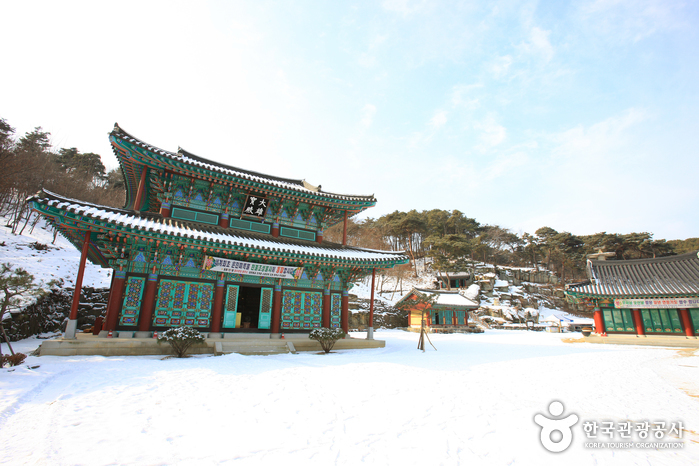
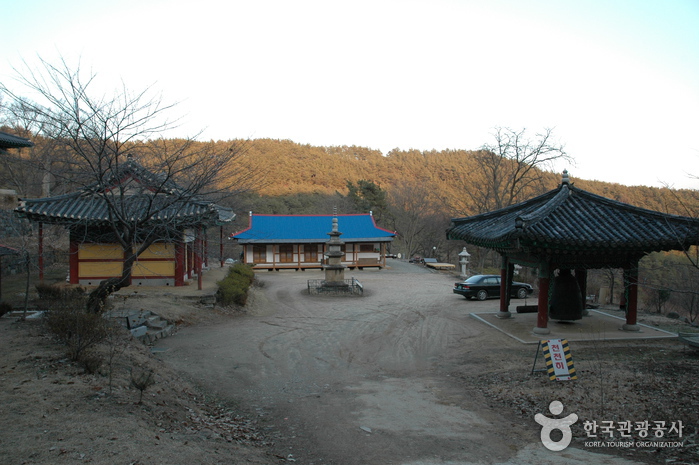

![Buyeo Naseong Fortress [UNESCO World Heritage] (부여 나성 [유네스코 세계문화유산])](http://tong.visitkorea.or.kr/cms/resource/71/2725771_image2_1.jpg)
![Buyeo Neungsan-ri Ancient Tombs [UNESCO World Heritage] (부여 능산리 고분군 [유네스코 세계문화유산])](http://tong.visitkorea.or.kr/cms/resource/31/212931_image2_1.jpg)
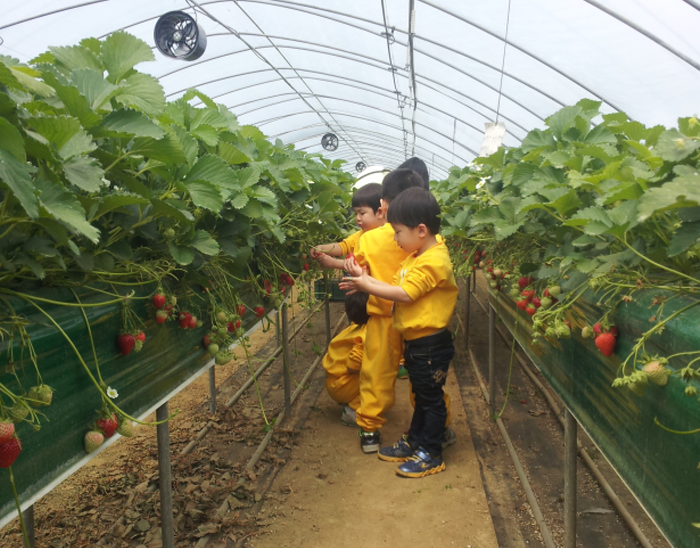
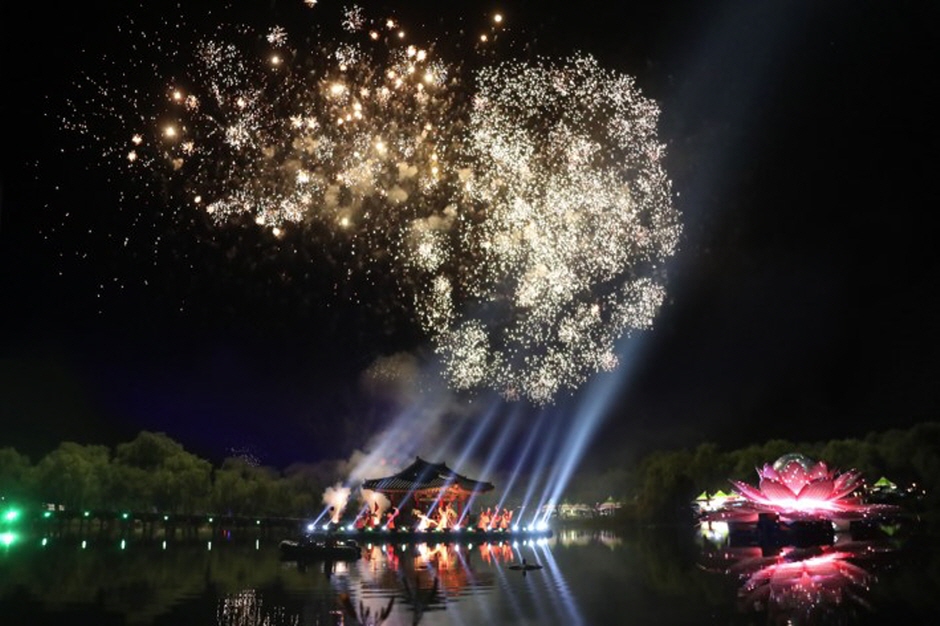
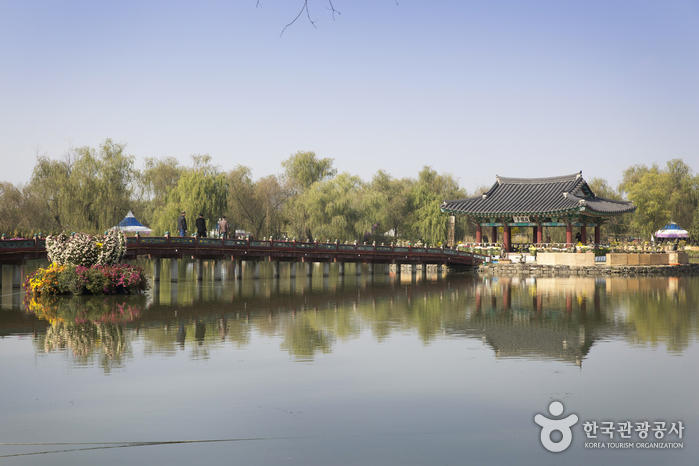
 English
English
 한국어
한국어 日本語
日本語 中文(简体)
中文(简体) Deutsch
Deutsch Français
Français Español
Español Русский
Русский